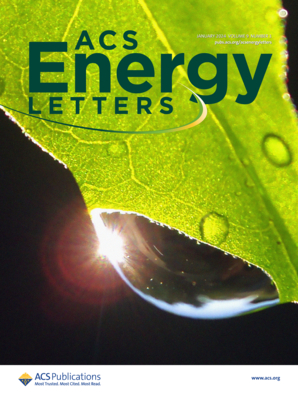揭示陶瓷固体电解质晶界缺锂的成因
IF 18.2
1区 材料科学
Q1 CHEMISTRY, PHYSICAL
引用次数: 0
摘要
实现低晶界电阻的固体电解质是推进全固态电池发展的关键。SEs中的高GB电阻通常归因于在这些边界处缺乏可移动离子;然而,这些缺陷在合成过程中何时以及如何形成仍不清楚。在这里,我们使用一种独特的原位扫描透射电子显微镜装置来指导固体电解质在退火过程中的结晶,从而在原子尺度上实时观察GB的形成,以Li0.33La0.56TiO3为模型SE。我们发现了一层厚度小于1.5 nm的超薄缺锂层,该层在结晶时出现在结晶前沿,并在两个相邻晶体融合形成GB时持续存在。我们对缺锂层的起源提出了两种假设,一种是基于热力学稳定,另一种是基于动力学约束。我们的结果为设计降低固体电解质中GB电阻的合成策略提供了指导。本文章由计算机程序翻译,如有差异,请以英文原文为准。

Unraveling the Origin of Grain Boundary Lithium Deficiency in Ceramic Solid Electrolytes
Realizing solid electrolytes with low grain-boundary (GB) resistance is critical for advancing all-solid-state batteries. High GB resistance in SEs is often attributed to deficiencies in mobile ions at these boundaries; yet, when and how these deficiencies form during synthesis remain unclear. Here, we use a unique in situ scanning transmission electron microscopy setup to guide solid electrolyte crystallization during annealing, enabling real-time observation of GB formation at the atomic scale, with Li0.33La0.56TiO3 as a model SE. We reveal an ultrathin, less than 1.5 nm thick, lithium-deficient layer that emerges at the crystallization front upon crystallization and persists as two adjacent crystals fuse to form a GB. We offer two hypotheses for the origin of the lithium-deficient layer, one based on thermodynamic stabilization and the other on kinetic constraints. Our results provide guidelines for designing synthesis strategies to reduce GB resistance in solid electrolytes.
求助全文
通过发布文献求助,成功后即可免费获取论文全文。
去求助
来源期刊

ACS Energy Letters
Energy-Renewable Energy, Sustainability and the Environment
CiteScore
31.20
自引率
5.00%
发文量
469
审稿时长
1 months
期刊介绍:
ACS Energy Letters is a monthly journal that publishes papers reporting new scientific advances in energy research. The journal focuses on topics that are of interest to scientists working in the fundamental and applied sciences. Rapid publication is a central criterion for acceptance, and the journal is known for its quick publication times, with an average of 4-6 weeks from submission to web publication in As Soon As Publishable format.
ACS Energy Letters is ranked as the number one journal in the Web of Science Electrochemistry category. It also ranks within the top 10 journals for Physical Chemistry, Energy & Fuels, and Nanoscience & Nanotechnology.
The journal offers several types of articles, including Letters, Energy Express, Perspectives, Reviews, Editorials, Viewpoints and Energy Focus. Additionally, authors have the option to submit videos that summarize or support the information presented in a Perspective or Review article, which can be highlighted on the journal's website. ACS Energy Letters is abstracted and indexed in Chemical Abstracts Service/SciFinder, EBSCO-summon, PubMed, Web of Science, Scopus and Portico.
 求助内容:
求助内容: 应助结果提醒方式:
应助结果提醒方式:


